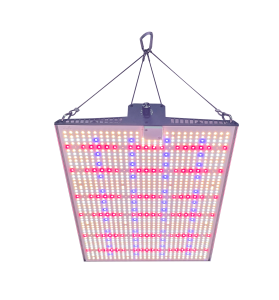When it comes to maximizing plant growth and ensuring a healthy harvest, selecting the right grow lights is crucial. At Shenzhen Andy Photoelectric Technology Co., Ltd., we understand the importance of having the right lighting system for your unique growing environment. Whether you are a hobbyist or a commercial grower, we offer a wide range of LED grow lights, HID lights, double-ended lights (DE), and ceramic metal halide (CMH) lights to suit all your growing needs. Read on to learn more about the different types of plant growth lighting and how to choose the best grow lights for your plants.
Types of Grow Lights: Understanding Your Options
When it comes to indoor gardening, grow lights play an essential role in plant health, growth, and yield. Below, we break down the most popular types of grow lights available on the market, along with their advantages and disadvantages.
 1. LED Grow Lights: The Future of Plant Lighting
1. LED Grow Lights: The Future of Plant Lighting
LED grow lights have become the go-to choice for growers over the last few years. Their energy efficiency and ability to provide optimal light spectra for plant growth make them ideal for a wide range of growing applications. With advancements in LED technology, these lights can now compete with traditional HID grow lights and are set to dominate the market over the next few years, with projections showing 90% of growers will switch to LED lights.
Advantages of LED Grow Lights:
- Energy Efficiency: LED plant lightsuse less power to cover the same growing area, typically consuming 30% less wattage compared to HID lights. This reduces your electricity costs and increases your return on investment (ROI) over time.
- Minimal Heat Emission: Unlike HID lights, LED grow lightsgenerate much less heat, which reduces the need for additional cooling and helps maintain an ideal temperature for plants.
- Adjustable Spectrum: Many LED grow lightsallow growers to adjust the light spectrum, providing a more customized lighting environment that enhances plant growth and development, particularly during the flowering and vegetative stages.
Disadvantages of LED Grow Lights:
- Higher Initial Cost: The initial cost of LED grow lights can range from $650 to $1100, depending on the brand and features. While the energy savings over time offset this higher upfront investment, it may be a concern for growers on a budget.
- Increased Dehumidification: Although LED lights save on cooling costs, they may require additional dehumidification in the grow space to maintain optimal humidity levels for plant health.
2. HID Grow Lights: The Traditional Choice
HID lights have been the industry standard for many years. They are available in two main types: Metal Halide (MH) and High-Pressure Sodium (HPS). MH lights are ideal for vegetative growth, while HPS lights are used during the flowering stage. HID lights offer high output and are widely available in wattages ranging from 250W to 1000W, with 600W and 1000W being the most commonly used.
While HID lighting has been the backbone of the indoor gardening industry, it is now facing stiff competition from LED grow lights and double-ended lights (DE).
3. Double Ended (DE) Grow Lights: High Efficiency for Commercial Growers
Double-ended (DE) lights are a popular option among commercial growers for their high light output and excellent coverage area. These HID lights are more efficient than traditional single-ended lights, providing up to 30% more light and coverage for the same wattage.
Advantages of DE Grow Lights:
- High Light Output: A 1000W DE grow light can cover a 5×5 or 6×6 growing area, making it ideal for large-scale commercial operations.
- Lower Cost: DE lightsare generally more affordable than LED grow lights, costing between $200 and $300 for the complete package, including ballast and reflector.
Disadvantages of DE Grow Lights:
- Heat Emission: Like traditional HID lights, DE lightsproduce a significant amount of heat, requiring additional cooling to prevent overheating.
- Ceiling Height Requirements: DE lights need to be placed around 4 feet above plants, which requires tall ceilings and may not be suitable for smaller, home-based grow setups.
4. Ceramic Metal Halide (CMH) Grow Lights: Superior Spectrum for High-Quality Resin
Ceramic Metal Halide (CMH) lights are known for their superior light spectrum, which enhances resin production and overall plant quality. These lights are available in two main wattages: 315W and 630W. They are typically used for vegetative growth, but some growers use them for flowering as well, particularly those focused on quality over quantity.
Advantages of CMH Grow Lights:
- Superior Spectrum: CMH grow lights provide a broader spectrum of light, which is beneficial for resin production and plant quality, making them ideal for high-end cannabis cultivation.
- Lower Heat: While CMH lightsare not as cool as LED grow lights, they are cooler than traditional HID lights, offering a middle ground for growers who need a balance between heat and light quality.
Disadvantages of CMH Grow Lights:
- Lower Yield: While CMH lightsare known for producing high-quality plants, they tend to result in lower yields compared to LED or HID lights.
- Higher Operating Temperature: CMH lightsstill produce more heat than LED grow lights, which may necessitate additional cooling systems to maintain optimal growing conditions.
How to Choose the Right Grow Light for Your Garden
Choosing the right grow light can be overwhelming with so many options available. To make an informed decision, consider the following factors:
- Type of Plants: Different plants have different lighting needs. For example, cannabis and other high-resin plants thrive under CMH lights, while LED grow lights offer flexibility for a wide range of plant types.
- Space and Ceiling Height: If you are growing in a small space with low ceilings, LED lights or CMH lights may be better options due to their lower heat emission and ability to be placed closer to plants.
- Budget: If you’re on a budget, DE lights or traditional HID lights may be more affordable options. However, LED lights offer better long-term savings on electricity bills and reduced cooling costs.
Shop for the Best Grow Lights at Shenzhen Andy Photoelectric Technology Co., Ltd.
At Shenzhen Andy Photoelectric Technology Co., Ltd., we offer a wide selection of LED grow lights, HID lights, DE lights, and CMH lights to suit every grower’s needs. Our high-quality products are designed to maximize plant growth while reducing energy costs. Whether you’re a hobbyist or a commercial grower, we have the perfect lighting solutions for your garden.
Visit our online store or contact us for expert advice on selecting the best grow lights for your plants. Our team of professionals is ready to help you optimize your grow space and achieve the best results.
Get the right grow light today and watch your plants thrive!































